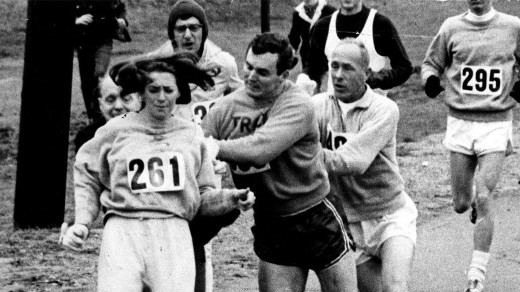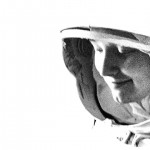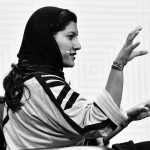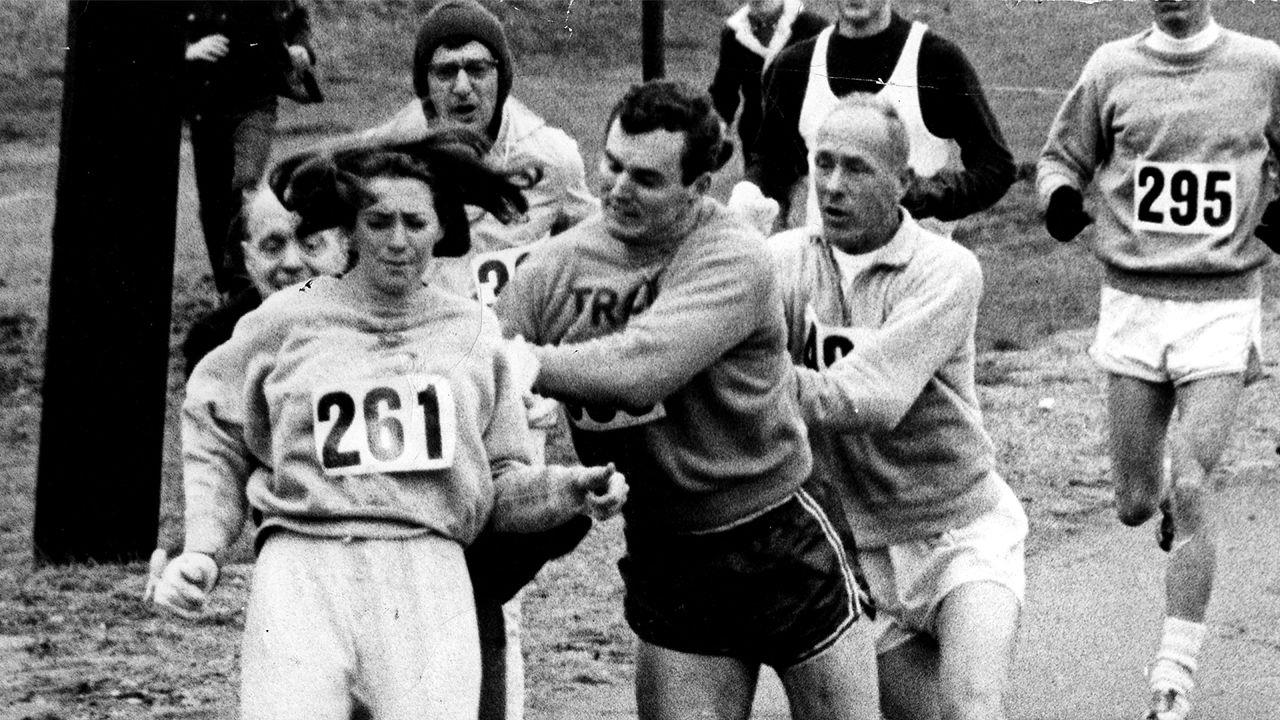Four Rule-Breaking Lessons From The First Woman To Run The Boston Marathon
How Kathrine Switzer’s history-making move in 1967 led to a career advocating for women in sports.
When Kathrine “K.V.” Switzer took her place at the starting line of the 1967 Boston Marathon, wearing a bulky, grey sweat suit and lipstick, she was about to make history. No woman had ever officially entered and run the venerable race before, although she had heard that a woman ran it the previous year without a bib number. Switzer had been training hard with her coach, Arnie Briggs, at a time when it was widely believed that women simply didn’t have the physical capability of running the 26.2 miles that make up a marathon.
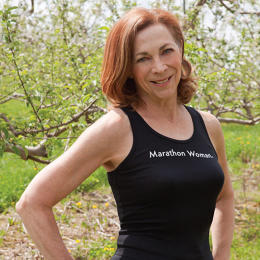
Switzer, then a sophomore at Syracuse University, was determined to prove that theory wrong. She was running with Briggs and her boyfriend at the time, Thomas Miller, when race official Jock Semple ran toward her to try to force her to leave the race at roughly the two-mile mark because she was a woman. Briggs yelled for the official to leave Switzer alone, then Miller threw a body block and knocked the official off the course.
“Then, the guys did hover in. Somebody said, ‘You’d better not try that again,’” she recalls.
Shaken, Switzer went on to finish the race and make a remarkable difference in women’s running and women’s sports overall. Her unwillingness to let the status quo stand and impose limitations she knew were false holds important rule-breaking lessons for all of us.
Breaking unwritten rules can be revolutionary, too.
Switzer and Briggs had reviewed the marathon rules prior to the race. There were no formal rules banning women, nor were there any questions about gender on the race paperwork, she says. She denies that she was trying to hide that she was a woman. The bulky sweat suit was a result of the weather, she says she routinely signed her name as K.V. Switzer. She says she was going as a celebration because she proved to her coach in practices that she could complete the race.
She also knew that she’d likely get some attention as the first woman to do so officially. But, she wasn’t expecting her run to become an international event or political statement, but that was the outcome, even though she didn’t do anything that was officially forbidden. The Boston Marathon stayed a “men’s only” race for four more years after Switzer’s famous run. Then in 1972, women were officially admitted to the race, with the requirement that they meet the same minimum qualifying time as men: 3 hours 30 minutes. The number of women participants nearly doubled from 1976 to 1977 (from 78 to 141).
There will be criticism. Tune it out.
After running for four hours and 20 minutes, Switzer touched off a period of polarization that lasted several years. She received hate mail and negative publicity. One journalist wrote, “I didn’t hate women golfers so much I would hate women runners more,” she says. Throughout, Switzer tried not to let the frenzy get under her skin. She kept the fan mail and discarded the hate letters. The ones that surprised her, however, were the angry letters from other women.
“Sometimes, the people who benefit most from change are the people who are most afraid of it. In this situation, many, many women would rather stick with the devil they know rather than the devil they don’t. They were afraid,” she says. Later, some of her vocal critics became her friends.
Consequences can turn into opportunities.
Semple had Switzer disqualified from the race, then had her expelled from the Amateur Athletic Union (AAU), the sport’s governing body. AAU membership was required to participate in many races, leaving Switzer unable to compete in some events until her membership was reinstated. But Switzer took matters into her own hands: she was determined to make running more accessible to women.
“It was like being excommunicated from the church if you’re a Catholic. It was the worst thing that could happen to an athlete, but at that point I said, ‘Screw you. Why do I need an organization that treats me like this?’” she recalls.
Switzer continued to compete, returning to the Boston Marathon in 1970 and winning the New York Marathon in 1974. She ultimately took her idea of organizing running events to Avon, where she was hired in 1977 to create and run the Avon International Running Circuit, which held 400 races in 27 countries for more than a million women. Her efforts helped demonstrate that there was enough international representation to make the women’s marathon part of the Olympics. Switzer was an important part of making that happen in 1984.
Share your story and new opportunities arise
Switzer says she became a motivational speaker “the day after the Boston Marathon,” taking her story to local Rotary Clubs and high school track teams. Today, she’s a sought-after speaker at much bigger venues and published her memoir, Marathon Woman: Running The Race To Revolutionize Women’s Sports, in 2007. She is also a longtime television journalist and has covered every televised Boston Marathon, including the 2013 event where terrorists detonated two explosive devices near the finish line, killing three people and injuring more than 260. The event was tragic and terrifying, but returning in 2014 was sweet, even as some speculated whether people would turn out for the event.
“Runners run for freedom. That’s the reason they run, and [I predicted that] anybody who can run is going to be back here next year because they are the most determined, persistent, fearless people there are,” she says.
Switzer continues to launch new ventures, including a clothing line and a new series of events bearing her original Boston Marathon bib number, 261. Switzer calls 261 a “movement,” that will include events and ambassadors that will help women embrace running. She says the concept is the result of women who reached out to her to say her story inspired them. The first 261 event took place in March 2015 in Palma de Mallorca, Spain. The 2016 event will take place on April 10. The goal of the events is not to be competitive, but to create a like-minded community of women helping women and becoming empowered by running.
“That’s a mighty force, because around the world there are millions of women, and many women who live [in] fearful situation[s]. If we can reach them with an empowering vehicle, that’s what the goal of this really is,” she says.
Fast Company , Read Full Story
(124)

